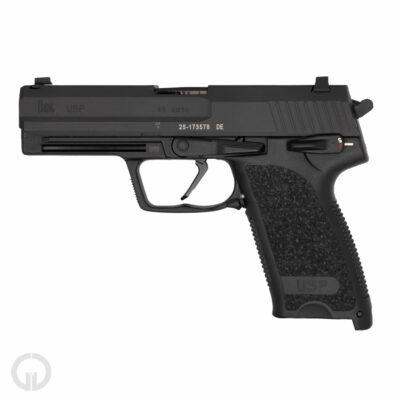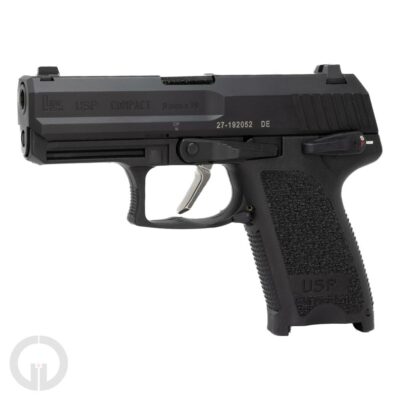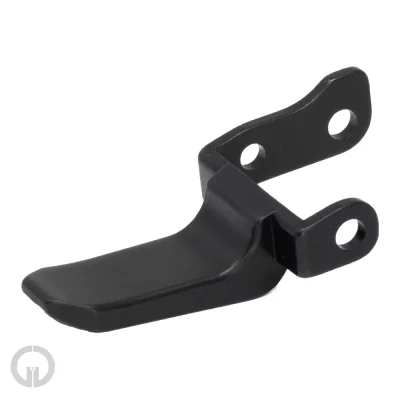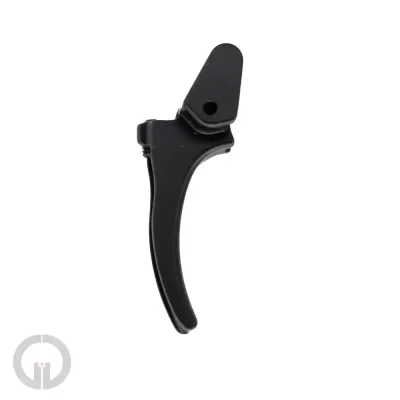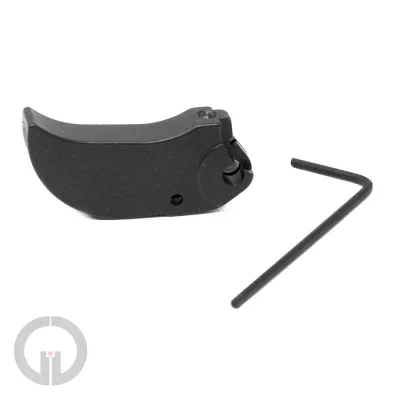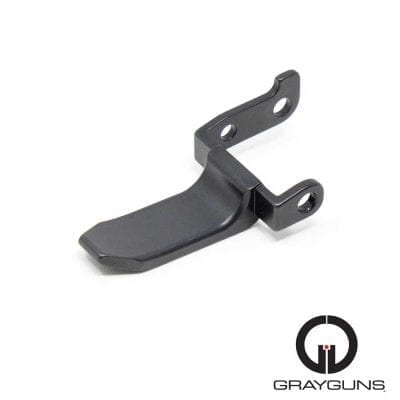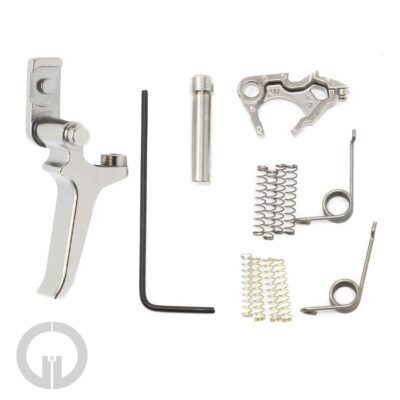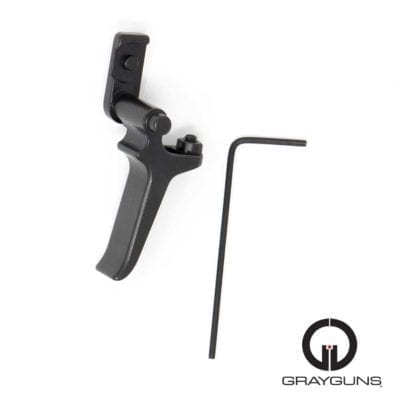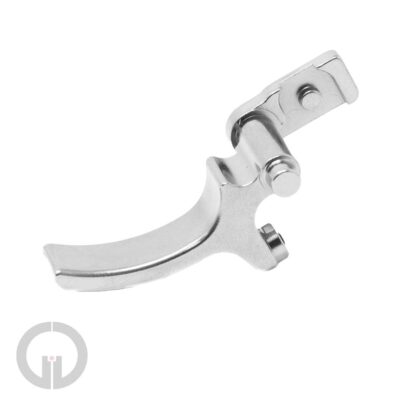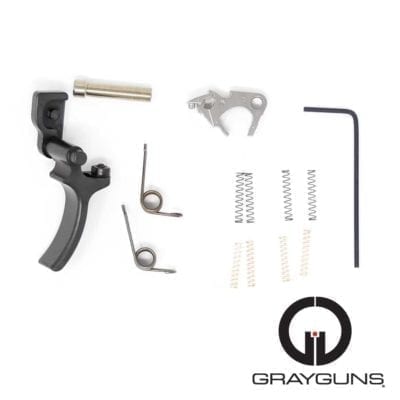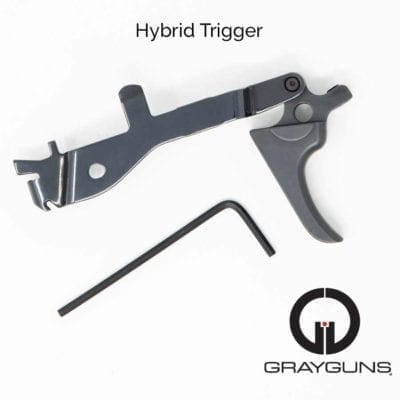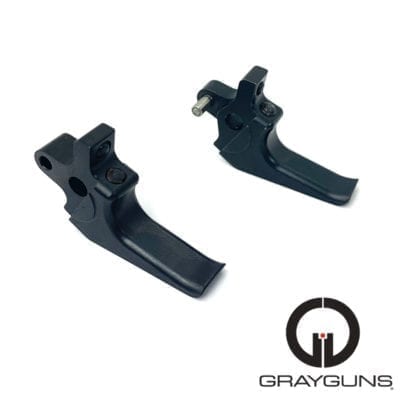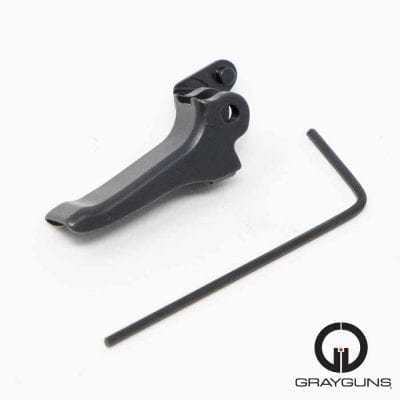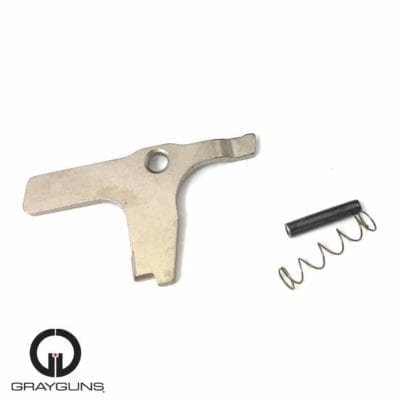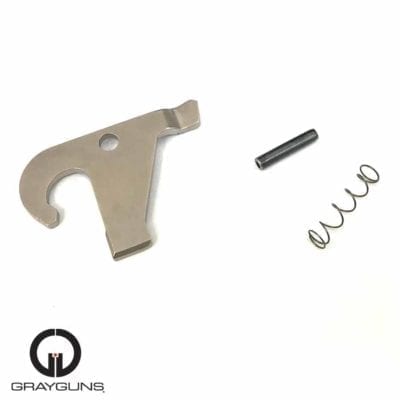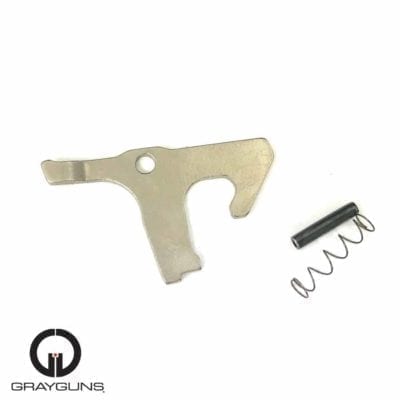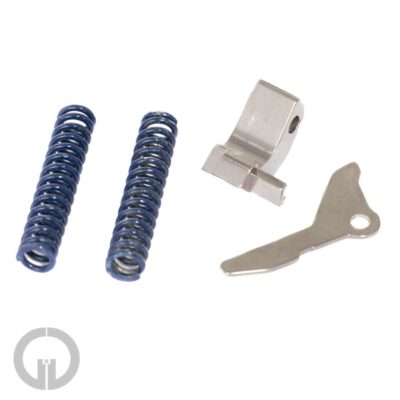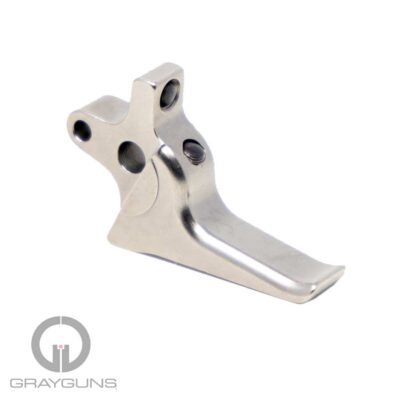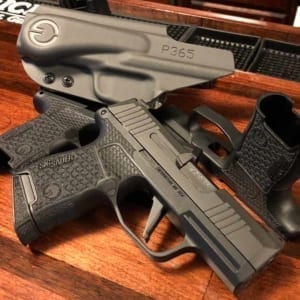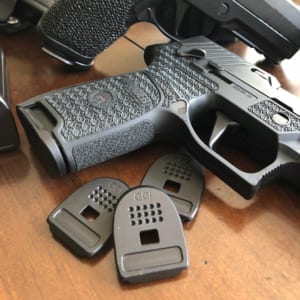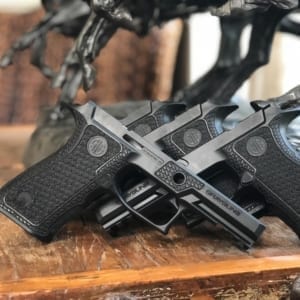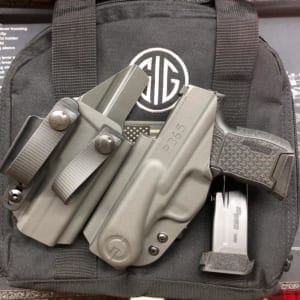Featured Products
-
-
-
-
-
-
-
Trigger Kits
P320 Adjustable Straight Trigger Kit – Competition
Rated 4.85 out of 5$159.00 – $164.00 Select options -
-
-
Trigger Kits
P320 Adjustable Hybrid Trigger Kit – Competition
Rated 4.80 out of 5$159.00 – $165.00 Select options -
Special Offer
SIG Enhanced Leverage System – P226, P229 & P228
Rated 4.90 out of 5$185.00 Select options -
Special Offer
P-Series SAO Dual Adjustable Straight Trigger – P226, P229, P220
Rated 5.00 out of 5$74.00 Select options -
-
-
-
-
Other Gun Parts
Grayguns Short Reset Trigger (SRT) Kit – P226, P229, P220
Rated 4.97 out of 5$85.00 Select options -
Special Offer
P-Series Dual Adjustable Curved Trigger – P226, P229, P220
Rated 5.00 out of 5$74.00 – $79.00 Select options -
-
Special Offer
SIG P-Series Adjustable Straight Trigger – P226, P229, P220
Rated 4.84 out of 5$74.00 – $79.00 Select options
FREE shipping on most orders $199 and up!
The free shipping offer does not apply to Firearms, Some Apparel, Custom Slides, or items in Bruce's Garage.
A Very Satisfied Customer
We purchased a P938 and were not happy with the hard trigger pull. It did not make shooting the gun fun, and we were disappointed with Sig Sauer’s trigger design.
The local gun dealer had a Sig Sauer representative during a promotion day, and we confronted him with our dissatisfaction. He gave us Grayguns information where a trigger kit was available to reduce the trigger pull.
When we delivered the P938 to Grayguns, Chris explained how the kit would reduce the trigger pull. At the end of Chris’ explanation, Bruce Gray came into the office and was introduced to my wife and me, and we had a brief conversation. He is a very knowledgeable person.
When we received notification that our P938 was ready for pickup, I brought a snap-cap along to see what the reduction in trigger pull would be. WOW!! What a difference from the factory trigger design. The work performed on our P938 and the interaction with Grayguns staff was above and beyond our expectations. We are extremely happy with the P938 trigger upgrade and it is now fun to shoot.
If we ever have a need for firearm work, it will be done by Grayguns.
Sights
They were able to install a front sight when a local gunsmith failed.
Outstanding
Grayguns not only offers amazing quality products but also the most helpful and responsive customer service I’ve ever dealt with. I ordered an ELS trigger for my P229 and attempted to install it myself. I made some mistakes along the way and couldn’t figure out why it wouldn’t reset.
I reached out to customer service, and they responded right away and began a long email thread on troubleshooting it with Chris in customer service. After several emails back and forth with pictures, videos, and explanations with possible resolutions, we decided it was best for me to send it in for the gunsmith to fix the issue.
Sent it out and got it back within three weeks. Gun shoots phenomenal now trigger is crisp and reset is minimal. Will definitely be coming back for future projects. Special shout out to Chris in customer services, you’re a legend my friend.
A great job.
Had the trigger and action cleanup for my SIG P320 AXG. Customer service was excellent and the performance upgrade is legendary. Thanks again.
Well done!!
Grayguns’ communication, service, and value exceeded my expectations. I was a bit skeptical, but the short reset trigger system is awesome. I am thrilled.
Experienced Professionals
Sent my 10-year old EDC (Sig P220 Carry) to GGI for a short trigger reset kit, along with a general once over and refinishing. Their gunsmithing work is absolutely top notch and their customer service is friendly, respectful and extremely helpful. Highly recommended.
NO BRAINER
I sent two H&Ks up for trigger work. Chris was unbelievably helpful. Due to my retiree travels, I missed a shipping date to get in the queue. Chris worked the guns in on the next available date.
Work performed perfectly, and I have put 200 rounds thru each weapon. The improvement over the factory trigger system (which wasn’t all that bad) was amazing! Trigger pull, travel, uptake and reset are all much improved, and both guns are now a pleasure to shoot and reliable beyond all expectations.
I plan to send several more guns up for modification as soon as Gray Guns releases their new upgrades.
I choose my upgrades carefully depending on the gun manufacturer and only use two or three shops to perform these upgrades. Gray Guns meets or exceeds my expectations every time, and anybody that wants to upgrade a factory system will be happy with the transformation Gray Guns provides.
Outstanding work for HK
I sent my first and then a second P7 to GG for their striker action package and was pleased with both guns when they were sent back. Nice crisp trigger, a short reset, all in all, a phenomenal upgrade to an HK classic. Always apprehensive about sending an older, rare gun off to have work done, but their work was top-notch and well worth the wait.
Fantastic Trigger Upgrade
I had been shooting a Sig Sauer P226 Legion with a GrayGuns trigger. What a terrific firearm! So then I bought an H&K P30SK (v.3, DA/SA) for EDC. It is a very good gun, but the DA/SA trigger was nowhere near as smooth as the P226. I had been spoiled by the smooth and light action.
So, I sent the P30SK to GrayGuns for the trigger treatment. What a difference! A very good gun is now a great gun. The DA and SA trigger weights were reduced by about ⅓ (12 lbs to 8 lbs & 5.5 lbs to 4.7 lbs, respectively). And smooth! No gritty feeling, no extra play, and a short but tactile reset. They even made the de-cocker smoother.
The service was great. I would highly recommend this GrayGuns trigger for any P30 model (or any P226, for that matter.).
Great workmanship, very reliable and high quality work
I have sent several firearms to Gray Guns, and have been most pleased. Excellent workmanship. I keep going back because I do not have to worry about the job not being done right.
Why Did I Wait So Long?
Purchased a Grayguns Sig P320 AXG Carry with Trigger, RDS Options. Transaction was very smooth and easy and I’m in their queue to have some work done on my older Sig P228. Have about four hundred rounds through it and I couldn’t be happier. It’s my first red dot so there has been a bit of a learning curve, but that’s on me not the pistol.
The pistols fit and finish are outstanding, and the trigger is friggin sweet. I highly recommend Grayguns.
How it should be from the factory
GrayGuns’ action work on my USP Expert is simply excellent. It feels exactly how the gun should’ve shipped from the factory. Extremely predictable trigger break, smooth action, and significantly shorter reset, all while retaining HK’s hallowed reliability and durability. I have the utmost respect and trust in this gun and will happily come back for more work from Bruce.
Action Cleanup Perfection Service – SIG P226
I’ve sent several guns to Gray Guns for trigger work over the years because they are the best! The double-action pull is lighter and incredibly smooth. The single-action pull and short reset feel amazing! Customer service is exceptional!
Exceptional
Found Bruce online through forums. Came highly recommended. After having work performed by Grayguns I’m able to confirm the rumors were accurate.
Work was perfect. It feels like a different pistol. Now it functions and feels how I expected it to. Zero issues.
The turnaround time was fantastic. Communication from start to finish was perfect. I have no problem recommending them for HK work. Many thanks to Bruce and his team. Will be sending any future needed work to you.
Great product better service!
I bought an enhanced leverage system and custom strut system, my gunsmith had troubles with the install. So, Chris at Grayguns had me send my gun to them and I got it back in 2 weeks, all I had to pay for was shipping 1 way! Couldn’t be happier, My 226 runs great.
Pete
Transformed the gun
I had heard many positive things about the Grayguns work on hammer fired HKs. I decided to see what they would to a P2000 I had plans to use as my EDC. Grayguns absolutely knocked it out of the park. They trigger is significantly better. Even with the heavy trigger return spring the action of the trigger is smooth and crisp. I think they took at least two pounds off the overall single action trigger pull weight. Then there’s the SRS they installed. Honestly, the P2000 and P30 series should come with this from the factory. The factory reset may as well have been letting the trigger out completely. Now the reset is a fraction of what it used to be. It makes shooting the gun fast a breeze. Lastly, is the nickel coating. Not only does it look good, but it helps all the parts slide smoothly together and it improves their durability.
Overall, I am very pleased. I could not recommend Grayguns enough for hammer fired HK work.
Trigger work
Had a new trigger installed, I am very pleased with it. Probably one of the smoothest and nicest triggers I have on my pistols.
Old School Pistol-Reborn
This new version of my old SIG P228 is amazing. New trigger, sights, and G-10 grips have transported this pistol to a new level of excellence. Special thanks to Chris Sweeten for all his help.
Trigger Clean Up
I sent my SIG P365XL in for P365 Trigger Clean Up with the Hybrid Trigger installed. The wait time and turnaround time were what they said it would be. It was a big improvement over the stock trigger and well worth the time and money.
Extreme satisfaction
I had never shipped a firearm nor had one worked on. Chris was so kind and professional, he made the process much easier than I ever expected. If Chris is not an owner, he should be! He walked me through the process and I easily shipped it. I watched the tracking and within an hour of it arriving I received an email from Gray Guns notifying me that the package had been received and logged into inventory.
I then received a phone call from Chris the same day telling me what the firearm needed to repair it along with an estimate. He sent a payment invoice including return shipping. I paid using their online portal. Chris notified me when they would ship it to me. On that given day, I received an email from Gray Guns along with a tracking number.
The firearm arrived on time. I signed for it. They don’t leave it on your doorstep. I fired a few hundred rounds through it. It functions flawlessly.
If you are indecisive about upgrading to the Short Reset or Flat Trigger, do not hesitate. It is much better than the factory parts and well worth the cost.
Meticulous and attention to detail
I don’t have enough good things to say about the work Grayguns did on my gun! Once I shipped it to them, they did the work right away, kept me apprised of the progress, and everything was done perfectly. They saw what I needed accomplished and they got it done perfectly!
Long term satisfied client
I have sent several HKs to Grayguns over the past decade and have always been impressed by their high quality work and parts. Their team has been consistently responsive, helpful and accommodating. They continue to be my trusted go-to place for any work on my HKs.
VP9 Action Cleanup
The trigger pull is SIGNIFICANTLY smoothed out, and the reset much improved. My receiving FFL gave me two points of comparison:
- The guy who worked there has been shooting a VP9 forever, and said he has several thousand rounds of “DIY Polishing” through it. The Grayguns action work and polishing had my trigger (with maybe 1,000 rounds total through it) easily on par with a more “well loved” pistol.
- Pulled one of the newer VP9s off of the shelf and did the Pepsi Challenge (google it, kiddos) with my gun. The Grayguns job on mine made the OTS VP9 trigger feel gritty and uneven by comparison. Beyond night and day.
Perhaps a better comparison is to the trigger pull on my P226 Legion (no surprise because the reset and guts are based on Grayguns concepts). Just a super smooth take-up and MUCH cleaner break on the shot through the whole trigger pull. I’ve been running my P226 in Action Pistol at my club all year, and now I have a tough decision to make on shooting Saturdays as to which pistol is making the trip to the club.
Very well done and worth the time and money. Thanks!
Amazing trigger job
Grayguns’ enhanced leverage system, short trigger reset, and custom guide rod turned my P226 into the most accurate P series pistol I own. I plan on sending the others for similar enhancements.
Phenomenal Gripframe
Initially ordered the incorrect size and was able to painlessly return it for the correct P365XL gripframe in my desired color. The fit and finish with the original factory FCU and aftermarket trigger and slide/barrel combination are excellent and the grip angle and ergos are superior. Very pleased with my new carry and the Gray Guns frame is the foundation of it.
HK P30 – Competition Short Reset
Had an HK P30 knocking around in the back of my safe with a broken trigger return spring for years. I had always enjoyed shooting the P30, and wanted to get it back into shooting shape. So, I decided to send it in to Grayguns for their Competition Action Job. I couldn’t be more pleased with the work that GGI did. Everything about the trigger is vastly improved; from reduced pull weight, to a solid wall, a crisp break, very little over travel, and a greatly reduced reset. Everytime I pull the trigger, I am impressed with how markedly smooth and improved everything is.
GGI has dramatically impressed me with how much more enjoyable shooting this pistol is, and I regret not having sent this P30 into them earlier. I am now considering sending GGI my HK USP Expert, and at least one of my already fantastic West German P226s in for similar treatment to see how much Grayguns can improve these pistols.
Worth the wait!
I have a German P220 that came with the narrow serrated trigger. It didn’t fit my hands. Grayguns machined the frame to fit a standard trigger and fitted their adjustable trigger. They really smoothed out the action. The trigger is crisp and perfect. I had to wait a bit to send it in but the turnaround was reasonable. The work they did is of course first rate. Thanks!
LOCKWOOD CUSTOM
This experience was flawless from start to finish. Communication throughout the entire process was exceptional! The work done by Keith and his team was unmatched. From the trigger work to the custom coating. Thanks Grayguns team!
ELS/Flat Trigger Expectations Exceeded
First, a review of the procedure for purchasing the parts and service and weapon shipping. Great price on the parts and labor for this upgrade. Grayguns spells out the purchase, waiting period (time in queue waiting for your turn for service) and the shipping procedure. I followed this to the letter and so did Grayguns. I was without my firearm for 14 total, including to and from shipping. To me this was simply amazing. Grayguns service and expediency, 5 out of 5 stars.
The ELS/Flat Trigger my Sig Sauer P220 Carry is incredible. I have never felt a double action trigger pull like this and couldn’t be happier!! But to me what is even more impressive, the single action trigger reset on this adjustable travel trigger!! Holy crap!! It is so crisp and definitive, it rivals ANY striker fired system I have ever shot and that includes Glock, Sig Sauer and Smith and Wesson.
I am a Sig P220 guy from way back and always will be. I recommend with absolutely no reservations, having the Grayguns ELS and the trigger shoe of your choice, installed on your Sig Sauer P series handgun. You WILL NOT be disappointed!
Short reset and flat trigger
I bought the P30 with the plan to add the GG short reset and flat trigger. It was a great gun to start with but even better with the trigger work. I did some of the work myself and the GG people helped with the trigger install. Great people, great service!!!
Custom Strut System and Enhanced Leverage System
I sent in an older Sig Sauer P220, which brought some special problems with it. Grayguns was able to overcome the issues and return the gun with a new enhanced leverage system and a custom strut system. They also replaced the recalled trigger, which I did not even know anything about and fixed a problem with the grips.
They had great communication throughout, and I am completely satisfied with the result. Thanks Gray Guns!
new trigger = new gun
I sent my P226 in for new ELS, Fat Custom Strut, and SRT – I have zero regrets. it was holiday time, and I could not justify purchasing a new firearm, but a trigger job on my IDPA pistol was exactly what I needed. It has made a noticeable and positive change to the pistol.
It was a simple and easy process, shipping thru an FFL, they beat the quoted lead times on the website. I am not good enough for it shave time off yet, but it increased my confidence AND I did notice immediately how smooth it operates and my sight picture hardly moves. Super fast on follow up SA shots.
Enhanced P30
Like most HK P30 owners, I love the firearm. However, there is some room for complaint with the trigger. I own one with a LEM, which is already an improvement (You must shoot one to appreciate it). However, the reset was longer than I wished. After doing some research, I decided to give Grayguns a try. I must be honest that I was tentative because I did not want to spend the money on a trigger job if there was only a minimal improvement.
Well, I had the Reduced Reset Carry Perfection Package done, and I must say it is awesome! The trigger is slick as oil, and what is amazing is that the Nickel PTFE coating on the internals makes the action silent. To explain the reset, I would say it is now like an Apex striker-fired trigger. If you are thinking, should I get this done, yes, you should! In the future, they will be getting my P2000 LEM.
New Extractor and short reset trigger
I’ve used Grayguns in the past and I can say they continue to do outstanding work. This was no exception, wow what a difference it makes to have my gun updated with a new extractor and short reset trigger. I would highly recommend Grayguns!
Very smooth and flat!
I sent in my FCU to have a slide and bull barrel fitted to it. Bruce did a fantastic job! The fit is 2011 smooth and accuracy is amazing! And it looks great 🙂
Above and Beyond!
I sent in my SIG P320 because I was beyond my scope of understanding what the issue was I was having. The gunsmith who worked on my order, spent quite a bit of time diagnosing the issue and then correcting it for me. He called to inform me of every step he took, always keeping me in the loop. Turns out, my desired configuration wasn’t possible due to incompatible parts. He reassembled my 320 back to OEM configuration and replaced a spring for me that I damaged.
I am extremely satisfied with the turnaround, price, and customer service that GrayGuns provided me for this service, and I would absolutely recommend them. Thank you again!
Excellent
I sent my gun in to have the Cerakote removed and bead blasted. Came out perfect.
Outstanding Action Job
Great action job on my H&K VP9SK! Pulled out all of the over travel and made the break as clean as could be on a striker gun. Coated all the internals and prettied her up a touch. Highly recommended and money well spent! Great job guys!
Confirmed with 40 rounds at 20 yards all in the 9/10 ring, slightly left all stacked in about a 5″ tall, 3″ wide grouping, 4 different kinds of ammo (Crit D 115g, Nosler Polymer tip 124g +p, Longhorn 124g SM FMJ, and Crit D 95g lite) in 8-12 second measured mag dumps. 2 fliers high right 8 and high left 7. Turns out my front sight post was about 1/16 off to the right. Corrected and confirmed as dead balls accurate.
Excellent trigger work
The upgraded trigger on my VP9 was a vast improvement over the factory one. It’s much easier to shoot accurately and it’s more fun! My only complaint is the shipping costs. Including shipping, the trigger upgrade cost me around $400. I would have considered buying an $1100 pistol over a $700 one with the trigger work.
Beautiful work!
When I first purchased my P30L I was very new to the DA/SA and always felt the trigger could be better. After hours of research on forums and YouTube I came across Gray guns. I only read great things about his work and couldn’t help but be intrigued and lust over how amazing my pistol could be. I sent in my pistol for the complete trigger work and man is it so much better. You definitely pay what you get and this was no exception to it. Thank you Bruce and staff for the awesome work!!!
Flat Trigger Job
Chris and Grayguns staff worked EXCELLENT with Fire Control Unit and hybrid flat trigger. In addition, they made a complete inspection and changed the barrel.
Excellent service and professionalism that I trust 100%.
Maximized potential
I sent in my P320 AXG Legion for a competition trigger system install. Great service and communication.
Overall: Greatly improved consistency, much smoother, reduced trigger pull weight with a rolling break. The feeling is that all trigger parameters/values are optimized within the design envelope of the gun. Well worth the price of admission!
Trigger work
Thanks to Grayguns, I have one of the smoothest triggers out there. I have shot competition pistols, and this one is right with them.
Exceeded expectations
I sent my P320 M17 in for a trigger install, armorers inspection, and to have a modern classic slide installed. I was trying to build a poor man’s 2011. I wasn’t expecting much, a new trigger shoe and a slide. How much better could it be?
We’ll, I was wrong in the best way possible. I don’t know what the Grayguns folks did, but my M17 feels like a hand-fitted gun. Cycling the slide is amazingly smooth. The trigger? Short and crisp. I honestly can’t believe it’s the same gun. Still need to add an optic and take it to the range, but I’m impressed.
The staff was also great. I was going to be out of town when my gun would ship. They were kind enough to hold the gun for me and ship it once I was home. On top of that, all of the communications I’ve had with the Grayguns team have been phenomenal. Quick to respond and nothing it professionals. I’m satisfied and already planning on sending them a few more guns to have them work their magic.
Best upgrade to a Hk
I used Gray Guns to install and trigger rest system on my P30SK; however, I was unhappy with the stock Hk trigger. I gave that gun to my wife and purchased a P30SKS as I like to have a manual safety on my pistols (I also own a couple of USP pistols.) When I received the SKS, I immediately sent it off to Gray Guns to have the SRS and Flat Trigger installed. I couldn’t be happier with those upgrades. I plan to send my UPS45CT to Gray Guns to have the SRS and Flat Trigger installed. If that works out the same way my P30s worked out, I’ll also send my USP9C in for work. Not a big Sig fan, but GG’s work on my HKs makes them my go-to vendor for pistol upgrades.
Made a great gun even better
I recently received my H&K USP 45 back from Grayguns and had a chance to take it to the range. My USP was already a great gun, but my friends at Jackson Armory in Dallas made me aware of the great work that Bruce Gray and his team do at Grayguns. I also heard about Grayguns triggers, because Wilson Combat uses Grayguns triggers for their SIG collaborations.
I sent my gun off to Grayguns and waited for Bruce to do his magic. What came back was a significant improvement over the factory trigger in the USP. I was able to quickly adapt my muscle memory to the new trigger and was placing solid groups on target with more speed than before.
Can’t say enough about the quality work they do. I’ve started the process to get them to do the same on my H&K P30 SKS.
Satisfied Customer
They did a trigger job and straight trigger install on my Sig P365. Very efficient customer service.
Amazing
The service is world class. Period. The work they did on my P320 is simply amazing. I think I might have the best SIG P330 trigger in the world. So happy. Thank you for the excellent work.
Upgrade
Grayguns took my H&K P30SK and upgraded the trigger unit. They installed a straight trigger, nickel-plated the FCU and performed an action tune-up on the trigger assembly. The reset is now short, and the trigger pull is less than stock. The result was faster shooting action. Excellent workmanship, and the end result was superb.
Perfection!
I sent my HK VP9 in to Bruce for trigger work. The VP9 trigger is one of the best out of the box triggers already, but Bruce and his crew did some amazing work. It now has a perfectly clean, short, and smooth rolling break. Turnaround was fast, and the customer service and communication was excellent. Big thanks to Bruce and shop manager Jordan for their excellent work!
Excellent Work
Sent my P320 X5 legion in for a competition trigger enhancement. I could not be happier with the result.
Fantastic work, flexible, and quick
I sent my P365 off to Gray Guns to get polished and the internals Teflon coated. Despite the fact that they say there’s a long wait online, I was contacted within about a month.
They made the process of shipping a firearm surprisingly simple. No FFL intermediary or anything. Work only took about two weeks and came right back to my doorstep. They were attentive and responsive and did exceptional work. I highly recommend Gray Guns for all your firearm work, especially Sigs
Great work, one of the “standards” of the industry is appropriately used
“Full job” HK P30. The gun was “out of the box.” About 200 or so rounds through it at the range to get a feel for it, then off to Grayguns it went. The work was perfect, red dot slide cut, internals, springs, and flat face trigger. All but my initials engraved on the side of the frame or slide was done.
Is now a “real” Grayguns HK P30.
Thanks to Bruce and the staff, all were on time. A lot of “where we are” emails and “it’s coming your way.” Two, or three weeks ahead of the estimated return time.
Trigger
Great trigger job
Disabled Competitive Shooter
I recently sent in my p320 for the competition package a trigger. I got it back in time to compete in the Adaptive Defensive Shooting Summit. The gun worked flawlessly and the trigger made quick accurate shots just that much easier. Would definitely recommend if you are a P320 shooter.
Excellence
Sent in two P226 Legions with Bar-Sto Match Grade Barrels for fitting. Flawless execution!
Later, I sent in a P229 Legion for an MRDS cut in the slide and fitting for a SIG Romeo Pro RDS—also, another Bar-Sto Match Grade Barrel. Needless to say, after some hiccups, the pistol arrived in flawless condition.
Lockwood Upper, well done Gray Guns!
I jumped in line early for the Gray Guns Lockwood upper and I have to say it was worth the wait. Fit and finish are what you would expect from custom work done by Gray Guns, perfection! Keith kept me updated when there were delays (no fault of Gray Guns) and I even received a personal call from Bruce Gray and had a very pleasant and interesting conversation.
I always felt like they really cared and that this was more than business, it was a personal goal to deliver excellence. I put thousands of rounds through the Lockwood upper in matches and in practice and I honestly feel it has made an improvement in my scores and confidence. Once I found the right ammo and spring combo (which is true for any competition gun), the complete gun has been flawless!
The gun feels well balanced and just adds a level of confidence I never had before. When the buzzer goes off, I’m ready to go to work! Thanks Bruce, Keith and everyone at Gray Guns.
A very fine handgun
I have owned my Grayguns P320 for several years, and it operates flawlessly after more than a thousand rounds. I recently upgraded to Red Dot on the Grayguns Slide, and I must say the balance of my new rig is outstanding. Needless to say, my accuracy has also improved with the Red Dot.
Perfection
I had the ELS Trigger installed. What a great shooter.
Very satisfied !!!!
Great trigger now …. Improves accuracy and reset is much better !!!! And did I say smoooth !!!!!
Ye ha, Can’t wait
Was looking to upgrade my P228, so I was searching the web and came across your website. Not only am I sending in (once you guys tell me to) my P228 for your Action Cleanup Perfection Service, Custom Strut System, Enhanced Leverage System and a few other tweaks.
Also purchased your Grayguns P320 AXG Carry with Trigger, RDS Options. Can hardly wait until the ten-day wait is over. All of the Grayguns staff I have interacted with have been very professional, and I know I’ll be doing future business with you.
Superior Work and Quality
I had Grayguns Gun Smithing install the Curve ELS, Custom Strut System and Short Reset Trigger Kit. The Elite Series already had a much improved trigger and SRT, but the addition of these Grayguns parts and their Gun Smithing work has taken it to another level.
DA/SA pull weights were reduced and smoothed out. Super short reset, once the trigger resets you’re already at the wall. Zero over travel.
Couldn’t be happier with the finished product and quality of work.
Flat trigger for USPc
I bought a flat trigger for my USPc in 40 with the LEM trigger variant. Upon installation, I had forward play in the hammer when the gun was cocked. Put the stock trigger back in the gun; no play. Put GG flat trigger back in, and the play returned.
Contacted Chris about it, and, after a few emails to iron out the details of the issue I was facing, he said he wasn’t sure why it wasn’t working and that they didn’t have an LEM variant in-house to see if they could replicate the issue.
I offered to send them mine as a test asking for nothing else in return other than for them to cover the shipping. They countered, saying if I paid the return shipping, they would nickel-coat my internals! They not only fixed the issue but my gun was upgraded and all for a nominal fee. I couldn’t be happier with the customer service or the quality of work done!
Excellent work!
The four pistols I listed were all sent to Gray for EDC combat carry work, and all are superbly smooth, functional and, above all, ultra-reliable. Chris the gunsmith is the point man at the shop and will answer all questions and, in my opinion technically proficient with all of my firearms.
My Hk USP now has a LEM trigger installed by Gray and its gunsmith. Superbly accurate and reliable. The nickel PTFE process on all handguns is a must. The crew at Gray’s is first-rate. My wife will not shoot my firearms unless it’s been to Gray’s .
Thank you for the tremendous gunsmith work. I highly recommend Gray’s.
Better than new
I sent in an H&K 45 USPC for the internal work package, trigger adjustment, and ambi-safety to be put on. The response from Grayguns is impeccable and complete every time they are contacted. If I had questions they were answered same day along with any adjustment to the work.
When I received the pistol back, I thought it was new! It works better than it ever has since taken out of the box. My wife shoots this better than I do, so she, of course, had to approve it. Well let me tell you I’ve never seen her so excited about a gun in my life. Her comments were about the trigger being so smooth not like it was gritty anymore.
The safety actually works now without having to use your other hand to decock or put on safe. The accuracy is better than I can shoot and it is much easier to control.
This is one of the best decisions I have ever made about work on a gun of mine.
Perfecting the Classics!
The first handgun I ever purchased was a classic Sig Sauer P225. When I fell on hard times I sold it to my dad, and later inherited it back when he passed. After many years of use and carry it needed a refresh and improvements. Bruce and his team installed their short reset trigger and tuned the action while retaining the look and feel of my classic Sig.
Now the DA trigger press is clean and smooth, and much lighter and consistent than factory, and the SA press is incredibly clean and crisp. Even more important than that, Bruce has the kindest heart and of anyone in the industry. He takes care of his team and is passionate about his work. Grayguns has a customer for life and I recommend them wholeheartedly.
Another great job
This is the second P320 I have had competition trigger work performed. Both guns were excellent and above expectations.
You feel like you are really important to Gray Guns.
OUTSTANDING!
This is the second VP9 that I have had Grayguns work on and I am thrilled with the results! There is NOT anyone else that can provide the level of quality work on a VP9 like Grayguns. Super smooth and reliable.
Excellent Work Once Again
Excellent work once again! I rarely offer testimonials because I expect good work. I make an exception with Grayguns because they are exceptional! For many years Grayguns has worked on many of my SIGs. I’m a frequent steel plate and action shooter. I’m also a real pain about what I want and extremely particular about trigger and action work.
Chris in Service and gunsmith Keith are superb and very responsive. Recently, I returned two SIG striker-fired pistols that had competitive packages done. Although the work was excellent, the triggers were a little too light for my action shooting. I returned the 320s and requested the triggers be 4 lbs. The guns came back with 4 lbs triggers and shoot great.
Thank you Grayguns.
Helped Free of Charge
I had an issue that they fixed free of charge. The issue was my own fault and they had me send it in and fixed it for free anyway. Great interaction and great service, highly recommended them if you need work done.
Smooth & fast
I purchased a Grayguns P320 Lockwood to shoot in USPSA and IDPA Carry Optics. This pistol is the fastest, most accurate, and flattest shooting handgun I’ve ever used. I’ve shot Glock 17/19/45s for years and Smith & Wesson M&P9s. They are all great handguns and can get the job done. However, the Grayguns P320 Lockwood takes performance to the highest level.
This handgun improved my draw time, split times, accuracy, and everything in between. I also have a Grayguns P320 Adjustable Hybrid Trigger in an otherwise bone stock P320, and I used this combination to win the 2023 IALEFI Top Gun Award at that firearm instructor conference.
Bottom line: The Grayguns P320 triggers, and the P320 Lockwood turn a good handgun into a GREAT handgun. It’s the difference between driving a Toyota Camry down the interstate and running an Indycar around the Indianapolis Motorspeedway. A stock Sig P320 is a good gun and can get the job done, but Grayguns turns it into a racecar. Give the Grayguns P320 triggers a go, and you won’t be disappointed. If you go all in with a Grayguns P320, prepare for a world-class experience.
Fantastic Trigger Work
Outstanding work on my HK P30L installing a Short Reset Trigger and a Gray Guns Flat Trigger. Amazing how much smotther the trigger is and the reset was much faster and more responsive. Definitely worth every penny for these upgrades.
Fantastic trigger job!
Sending in the pistol was a bit of a pain. Now that FedEx and UPS along with USPS all not shipping firearms w/o an FFL. The guys at Grayguns were really helpful. My local gun store was willing to ship to them for free.
The trigger is fantastic. Prior to the mod, I was shooting 0.2 sec splits on my Bill Drills etc. After the trigger job, consistently shooting .17-.18 sec splits. Love it!
Great trigger job!
I sent in my HK P30SK for the Gray Guns reduced reset trigger job and for installation of the 4.1 trigger components too. The communication with Gray Guns was excellent, once I notified them of my interest, they let me know when to ship. Once the work was completed and payment made, it was shipped promptly. The work and trigger job was excellent, and I highly recommend them for HK work.
P365 is now usable with bigger hands
I needed to carry my P365 for a year, and through regular training with it, I found out how much my plus-sized hands (XL-XXL gloves) hated it. Jumping out of my hands in bill drills. Difficulty getting a solid purchase on the grip, to the curve of the trigger being too tight for my finger.
Developed proficiency, did the year, and put it in the back of the safe to hopefully never need to carry it again.
After a year of neglect, I decided to send it to Grayuns (I have had them work on others, so this was not out of the blue). Grip module, trigger. Carry service. What I got back was a huge improvement. The finger fits on the trigger, and the adjustment and service worked out great. Maybe most importantly, that grip module. With such a great purchase on the grip it just doesn’t jump anymore! So much more controllable. So much easier to use after their work. Now, I bring it with me to the range to maintain some proficiency.
Turned from something I despised to something I’m comfortable with.
Unparalleled Service
I’m thrilled with the trigger work. It did exactly as promised and was worth every penny. What truly sets these guys apart is the communication and willingness to satisfy personal requests. I plan to have them work on several more weapons in the very near future.
Trigger work
Interestingly enough, the triggers that come from the manufacturer are heavier/stiffer than necessary, I assume for safety and liability purposes. However I found that the original ones on my VP9s were better than on other pistols I own. Nevertheless, Bruce is a master technician, having built many competition level 1911s and I was interested to see what improvement he would make to the trigger on my HK VP9SK.
I sent it to him and was very pleased with the results and turn around time. He also did the trigger on my SIG P320. Now these are not what I would consider “hair” triggers but very adequate for a carry pistol. I was certainly pleased with Bruce’s work and would highly recommend him.
Excellent, Quality, and Professional Work
I sent my new SIG P320 Equinox Striker pistol to have a new adjustable trigger installed. They provided excellent work. I own numerous SIG pistols and have sent all of them to Grayguns to have new triggers installed.
Four SIG 320’s with Competition action job
Over the space of a few years, I sent in four SIG P320s – each for a competition action job. These include an X-5, a full-size P320, a special edition VTAC 320, and lastly an X-10. After I got the first gun back (the X-5) I decided that any future SIGs I bought would have the Gray action job.
Each of the triggers is 100% reliable and smooth as silk. Trigger pull varied from 2 1/4 pounds on the X-5 to 2 3/4 on the X-10, but they all “feel” the same. There’s no mushiness or grit in the trigger pull, and each reset quickly, reliably, and at a consistent point
I have shot thousands of rounds in those four pistols, and I have NEVER had a failure to function. I’m really quick to tell anyone I see with a 320 about the benefits of Gray’s action jobs.
Outstanding Service and Patience
The team at Grayguns not only took the time to walk through the options I had, but they completed all work at such a high degree of quality I wouldn’t hesitate to work with them again.
I sent in an HK USPc to have a short trigger rest and lighter pull installed. I also ended up upgrading the trigger to a flat trigger. It all came back wonderfully done. Great group of people.
Quality work
The HKP7 is a great weapon, but finding someone to work on it has been a mission. Bruce Gray has a reputation for excellence, so when I found out he had a gunsmith that worked on the P7, it was a done deal. Yes, there is a wait, and quality work is not cheap, but it was well worth it. Communication from Gray’s was excellent, letting me know when they received the firearm, when it hit the bench, when complete and when shipped out. They truly exceeded expectations.
Great Work
I definitely recommend the trigger and installation service Gray Guns provides. The trigger on the P320 is okay from the factory. With this upgrade from Grayguns, it definitely cleans up the trigger pull and reset for a more pleasant shooting experience. It was nice knowing that I had professionals install the trigger.
Someone to Trust With Your EDC
I sent my Sig Sauer P220R to GrayGuns for an upgraded trigger and refinishing after 10 years of use. It was returned better than new. Their customer service is outstanding. They are extremely knowledgeable and respectful. They answered all my questions and kept me updated on their progress. I highly recommend their services.
Worth evey trigger press 🙂
As a proud owner of a Wilson Combat P320, I always enjoyed my Grayguns trigger and competition trigger job. I honestly enjoyed it so much that I sent my other P320 in to get the same thing done. The communication from beginning to end was fantastic; the team really went above and beyond.
Once I had my P320 back in my hands, I was amazed at how different it felt from before … it feels almost identical to my WCP320. Impressed with the result on the P320, I also sent in my P365 Macro Comp because I only trust Grayguns to work on my triggers.
Fantastic service
Both the service and Gunsmithing departments are the best you could want. Their products, attention to detail, and overall customer service should be the envy of all others.
Even better than I hoped
I sent my HK P30L in for a trigger job. I got the short reset, as well as the flat trigger. All I can say is wow. I really liked the P30L before, but it is an absolute shooting machine now. I recommend this work for anyone looking to get the best possible performance out of their pistol.
Exceeded Expectations
I recently purchased a new Sig Sauer P226. After shooting it a few times I just couldn’t accept the trigger creep it had from the factory. I’ve been shooting handguns for over 40 years and all of my weapons have had trigger/action work, so I’m a bit spoiled and particular. A local shop recommended GrayGuns. I emailed describing what I was looking for, and was surprised when I received a call from Bruce Gray! We had a short conversation where he asked a few questions to understand my experience and what I was probably looking for. He then recommended the service that I agreed to. The wait was worth it. The pistol functions exactly as I could have hoped for.
I expected quality work. What surprised me was the personal customer service that is very much appreciated.
Competition Trigger System
Excellent Work, light pull, short reset. Plus the extended magazine release is perfect.
LEM perfection
I sent in my HK P30SKs, and P30L for the reduced reset package on all three. Follow-up shots are much easier and faster with less opportunity to disturb my sight picture. I love the LEM trigger for concealed carry, and this makes it that much better. Overall, I’m very happy with the finished package.
Helpful communication and great service
I appreciated the email and phone discussions helping me understand trigger job options, prices, benefits, etc. When ready to go, nice help getting shipping set up for me. After sending my pistol in, turn around was quick and billing was as quoted. Got pistol back with new short reset trigger, ELS, and suppressor sights installed. I was surprised by how short the short reset is — not much more than a twitch of the finger. All original parts returned with the gun. All good. Honest good service start to finish.
Grayguns ELS Made a Good Pistol Great
I had the Grayguns SIG P-Series DA/SA Enhanced Leverage System, Short Reset Trigger (SRT) Kit, and Fat Custom Strut System installed on a P226 Extreme. The pistol had a factory SRT installed and I wasn’t certain how much of a difference the Grayguns parts would improve my experience but I felt an immediate difference.
The trigger weight was significantly reduced and the adjustments of the pretravel and overtravel made the trigger much more crisp. The reset feels almost immediate now and my groupings at the range are much more tight.
Great Job!!
I wanted to make an everyday gun that is small but shoots up with the bigger guns. So I bought a H&K P30 SK and sent it to Grayguns to trick out. Boy, did they! Very smooth single and double action! Highly recommend their work!
Thank You, Gray Guns!
Absolute the best quality products and service
Bruce and the guys over here at GrayGuns make some of the finest products and offer some of the best service. I have purchased a Modern Classic slide for my P365 and P320. They are extremely elegant and functional. The serrations are extremely grippy and allow for easy press checks and slide manipulation. Probably one of the best slide designs, execution, and attention to detail I could ever ask for.
Their Flat Trigger and Competition Trigger kit are the best trigger you can purchase for a P320 and P365. It has a crisp break and easy adjustment. The Competition Kit allows you to change sears, sear springs, trigger bar springs. My P320 has one of the nicest triggers I have ever gotten to lay a finger on.
Butter smooth
I have an original West German P226 and loved the gun but wanted a red-dot option, so I picked up a new P226 pro-cut with a short reset trigger. After a few hundred rounds, it was nice but nowhere near my original west german, so I sent it to Grayguns. They did the custom strut and enhanced leverage system with a straight trigger.
Just got it back and out to the range, love the outcome. My friend says it shoots better than his legion. All I know is that I am supper happy that I sent the gun out. It was worth the wait to get it in at Grayguns
Even with a gunsmith screw-up, they still get 5 Stars and C.S. Rep. Chris S. Should get a Raise/Promotion !!
Sent the daughter’s P365 in for a curved gold trigger and a trigger/action job. It’s a long story, but Chris is a 5-star customer service rep because they put in a straight gold trigger.
He fixed the gunsmiths not reading the order correctly in record time. More or less. LOL
Trigger take up smooth as butter, not crunchy anymore. The break is smooth and much lighter. Over-travel and reset is considerably shorter and also smooth as silk, with a nice felt “click” on reset. Action is like glass.
All in all, I am completely satisfied. Even with the screw up of someone putting the wrong trigger in. I have to give Grayguns 5 stars.
And as I put on the note to Chris’ boss, if it wasn’t for his excellent customer service, in fixing the wrong trigger install, and over the Holidays no less, my daughter still might still be waiting for her shooter.
She loves the curved gold trigger. It really makes it “Her shooter.” Thank You Chris! As I told your boss in the note, you deserve a raise!
Well Done!
Great communication and value. The work done on my gun was flawless and came back cleaner than I’d sent it!
I plan on several more upgrades.
100% satisfied customer
I ordered the flat trigger and short reset for my P30SK and had a highly recommended local smith do the install. After two weeks, I picked it up, and the trigger would not rest without me pushing the trigger forward. The smith took the firearm for another week and called for me to pick it up. The same issue with the reset; the smith said it was due to the new spring, and it would work itself out.
I contacted Chris at Grayguns, and he immediately responded, give me a call. I did, and he said, please send us your firearm; this in no way should function like this. Two weeks later, I received my firearm, and it’s the by far my favorite of my collection. It’s also my EDC, so having confidence in a functioning trigger is my top priority.
As for the flat trigger and short reset system I ordered … I always loved my HK but was extremely unhappy with the trigger. All I can say is WOW; there really isn’t a comparison I can explain because they do not compare.
Thank you Chris and Grayguns staff.
P365 Project
Sent my P365 XL in for their Grayguns adjustable flat trigger, action cleanup and extended magazine release. Night and day difference with a really nice break. I will be back.
These guys know what they’re doing
Initially intended to use a hammer, sear, safety lever kit from another vendor, however studying how SIG’s SRT worked convinced me to use Graygun parts instead. The result was a smoother DA and reduced SA trigger pull that is both lighter & crisper than with factory parts. The work order / invoice process was smooth and turnaround time was excellent. I especially enjoyed interactions with Grayguns gunsmithing’s Chris. All the people I spoke with were friendly and helpful.
The major issue with this project had nothing to do with Grayguns but with the information provided by Dave Spaulding’s Combatives. There were two sight kits: P-Series & P320. As it turned out the P-Series kit – the logical first choice – produced a high POI. To the gunsmith(s) at Grayguns when I provided the P320 as-well-as the P-Series sights they correctly installed the #6 front with .250 rear. This gives a good POI for a traditional center hold sight picture with 124 gr. JHP +P ammunition. It should be noted that the two sets rear sights had identical patterns. Kudos to the Garyguns team for removing both the #8 front and .270 rear from the P-Series set.
Brought Back New Life to an Old Pistol
Sent in my USP Compact .40 in to have the short reset kit correctly installed and to fix an issue with the control lever. Along with the nickel flat trigger it feels like an old loved pistol has been brought back to life. Great service with friendly knowledgeable people.
You guys are the best
Sent in a W. German 228 to get some action work and cerakoting done. Old gun feels practically new! Did the 1,000 round test, functions great with factory and aftermarket mags. I recommend these guys for all Sig work on your ol’ hammer guns. Might send in the P320 next for some work when it needs it!
Thanks Grayguns!
Another great SIG tune up
I have had three of my SIG P320s tuned up by Grayguns. I really like the shape of the hybrid trigger. I am not a fan of the straight triggers. When I saw they finally offered one for the P365XL I sent my P365XL in for tune-up and trigger. Great job, fast turnaround.
Great working with Grayguns
The first thing I want to mention is that your customer service is the best. I’ve had correspondence with Penny and your gunsmith Nick and both of these people answered my questions fully and very quickly. The pistol I sent in this time was my HK USP9. The work done was the HK Competition Action Work. In addition, I had a set of Trijicon sights installed while the pistol was being worked on.
During the modifications, I asked Penny if you were able to provide Cerakote finishing. With a positive response from Penny, I requested an OD finish for the receiver. The Cerakote finish came out great! Very detailed with no over spray whatsoever.
The competition action work also came out great and the single action break is the cleanest I’ve experienced of all my HK pistols. I’ve had several other HK pistols worked on by Grayguns, and I’m currently in the planning stages for my next project with you. Many thanks for the quality work you do and the great people you employ.
Wonderful trigger!
I sent in an HK VP9 for an action job and install an HK Flat Trigger. They nickel-plated all of the moving parts and worked their magic.
The trigger is smooth and crisp. HK has a very good OE trigger. Grayguns makes it a great trigger. I would highly recommend Grayguns for your HK or SIG action job. Yes, it’s expensive, but well worth the price of admission! I plan to send in my SIG P320 in the future.
Great workmanship
I sent in a H&K P30SK to have the double action and single action improved. Also, to have a straight trigger installed. The action was tuned, the trigger replaced, and the action was nickel plated. Everything was beyond my expectations.
I am very happy with my purchase
I was able to purchase a GGI-P320 back in July and it was a beautiful safe queen until today. I had a momentary panic attack after removing the slide to add some synthetic grease, and after reassembly, the trigger was locked. I contacted customer service, and my problem was quickly solved thanks to Chris and the knowledgeable people at Grayguns (new guns are very tight).
After Grayguns helped solve the trigger lock-out problem, I made it to the range, and 190 rounds later, I am very happy with my purchase. Grayguns provides crisp clean breaking triggers with a great short rest and the balance in my hand while shooting was outstanding. After remembering to place less finger tip on the trigger my shoot grouping moved right back into the 3 to 4 inch center ring group shots while working my way back to 20 yards (reactive small bore rifle targets work great).
This pistol is worth the wait time and the price. My recommendation if you want a very good competition grade pistol is to get on the email waist list and act quick when you get the notice of the GGI-P320-4.7PRO-AXG is available because they sell out fast.
The only thing missing on the beautiful pistol is GGI grips. Makes me wonder for the price why Grayguns did not make the pistol easy to ID as one of their works of art with the GGI P320 AXG Hogue G10 grips (just a thought).
Great work Grayguns.
Grayguns on Instagram
California dealer highlight!
Grayguns Director of Dealer Sales, Alice, recently made a road trip behind enemy lines into the wonderful state of California, stopping by many of our dealers.
We feel even though we dislike the politics of the state we still want to support all of our fellow second amendment supporters there and help them with their Sig and HK needs.
If you are interested in becoming a dealer please reach out!
@gretasgunsoriginalpage
@riflesupply
@evolution_ak
@gun_locker_hesperia
...
“Glory to God in the highest, And on earth peace, goodwill toward men!”
Luke 2:14
We hope that everyone finds blessings this Christmas, joy surrounded by family and friends, and the light of the spirit within them, even if during the darkest of hour. Merry Christmas to all...
...
Grayguns News
Grayguns P320 Trigger Exchange Program
The program is for customers who purchased our Practical Enhanced Leverage Trigger (PELT), or sent their P320 to Grayguns for action enhancements. We also have published videos on how to remove your trigger.

